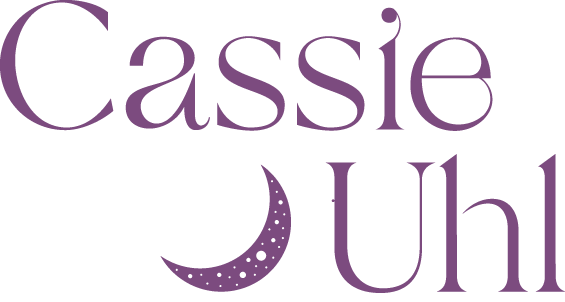- Astrology
- Auras
- Beltane
- Breathwork
- Candle magick
- Card spreads
- Cassie Uhl
- Chakras
- Cleansing
- Crystals
- Dark moon
- Death Care
- Divination
- DIY
- Dreams
- Elements
- Empath
- Energy work
- Free download
- Full moon
- Goddess
- Grief
- Handmade
- Herbs
- How-to
- Imbolc
- Intuition
- Journaling
- Letting go
- Litha
- Lughnasadh
- Mabon
- Magic
- Mantras
- Meditation
- Moon phases
- Mudras
- New moon
- Numerology
- Oracle
- Ostara
- Palmistry
- Plant Allies
- ritual
- Rituals
- Runes
- Sacred geometry
- Samhain
- Seasonal magick
- Shadow work
- Spellwork
- Symbolism
- Tarot
- The Ritual Deck
- Waning moon
- Waxing moon
- Wellness
- Wheel of the Year
- Winter Solstice
- Witchcraft
- Yoga
- Yule
- Zodiac
- air
- apple magic
- apples
- aquarius
- aquarius card spread
- aquarius ritual
- aquarius season
- aries
- astrology
- aura protection
- auras
- autumn equinox
- beltane
- cancer
- cancer season
- candle dressing
- candle magic
- candle magick
- capricorn
- card spread
- cast a circle
- casting circles
- cauldron
- Ceres
- chakra energy
- chakras
- channeling
- charging
- cleansing
- correspondences
- creosote
- Creosote
- crone
- crystal healing
- crystals
- death doula
- death positivity
- death work
- Demeter
- divination
- diy
- dream ritual
- dream rituals
- dream work
- dreams
- dreamwork
- eam
- earth
- eggs
- elements
- emotion code
- empath
- energy
- energy cleansing
- energy protection
- energy work
- fall equinox
- feeling auras
- fire
- four elements
- free meditation
- full moon
- full moon energy
- full moon in gemini
- full moon in pisces ritual
- full moon in scorpio eclipse
- full moon ritual
- gemini
- gemini card spread
- gemini season
- goddess
- grandmothers
- gratitude
- Great mother
- grief
- grief tending
- harvest season
- heart chakra
- herbal magic
- herbal magick
- herbal magick 101
- herbs
- high priestess
- house cleansing
- imbolc
- improving intuition
- infertility
- infertility awareness
- intuition
- intuitive healing
- jen isabel friend
- kunzite
- lammas
- learning tarot
- leo
- leo season
- letting go
- libra
- libra season
- lughnasadh
- Lulu Tineo
- mabon
- manifesting
- meditation
- moon phases
- mother meditation
- mother's day
- new moon
- new moon card spread
- new moon in capricorn
- new moon in leo
- new moon in libra
- new moon meditation
- new moon ritual
- north
- nurturing mother
- oracle
- oracle card spread
- ostara
- pendulum
- pendulums
- Persephone
- pineal gland
- pisces
- pisces full moon ritual
- plant connection meditation
- Plant magic
- popular
- protection magic
- protection magick
- reiki
- releasing
- residual energy
- resiliency
- ritual
- samhain
- scorpio
- scorpio season
- scrying
- seasonal magic
- seeing auras
- shadow work
- shamanic healing
- sigil
- smoke wands
- spell bottle
- spellwork
- Spirits
- spiritual
- spring equinox
- tarot
- tarot myths
- taurus
- taurus season
- the four elements
- third eye
- triple goddess
- understanding the earth element
- virgo
- waning moon
- water
- water is life
- waxing moon
- what are death doulas
- wheel of the year
- winter
- winter solstice
- witch bells
- working with auras
- Yolia Botanica
- yule
- zodiac
Dreamwork 101 // What is Dreamwork and How to Get Started in 5 Steps
Dreamwork is the practice of tending to our relationship with our dreams. We’re dreaming every night, but many of us barely remember our dreams, or if we do, don’t spend much time thinking about them or working with them.(How often have you dismissed a dream as, “oh, it was just a dream?”)

Dreamwork is the practice of tending to our relationship with our dreams. We’re dreaming every night, but many of us barely remember our dreams, or if we do, don’t spend much time thinking about them or working with them.
(How often have you dismissed a dream as, “oh, it was just a dream?”)
But dreams can have a lot to teach us and offer us when we enter into a deeper relationship with them. The dreamworld is rich with feelings, desires, needs, and possibilities. Our understanding of what the dreamworld evokes and presents can support our physical lives and our connections to ourselves.
In this blog post, I’ll share a bit about how to start a dreamwork practice of your own.
Dreamwork Lineage
First, I’d like to share my dreamwork lineage. What I know about dreamwork comes from the work of these folks in particular, as well as my own intuition and my ancestors:
These are wonderful people to go deeper into dreamwork with if you feel so called.
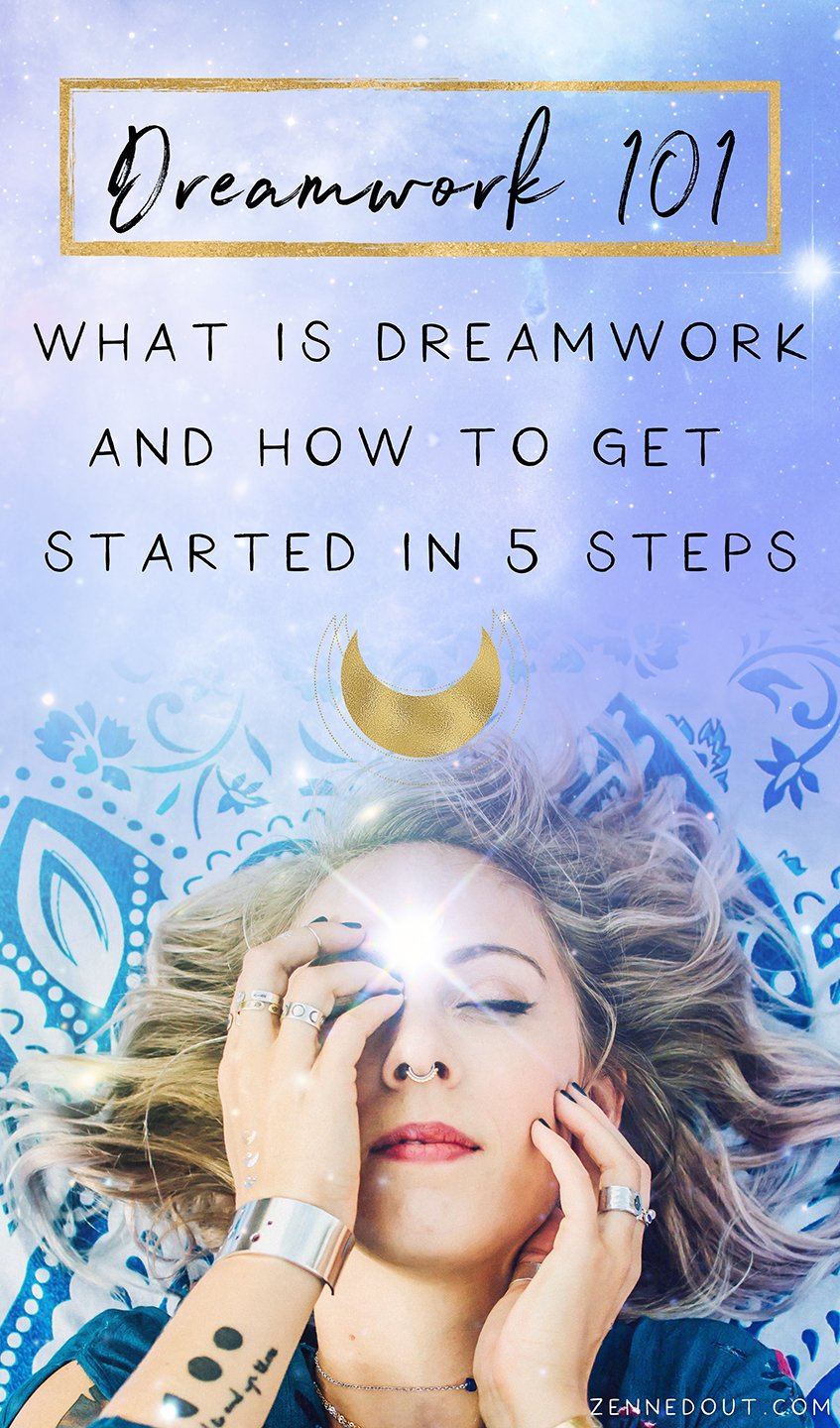
1. Support Dream Recall + Sleep
The simplest of ways to begin supporting your dreaming is by supporting sleep and dream recall. It’s difficult to consciously work with our dreams if we’re not sleeping well or can’t remember our dreams when we wake up. Everyone is different, but here are some things you might like to explore to support your sleep:
Set screen time boundaries for a certain amount of time before bed
Drink a tea to support your sleep, like chamomile (always do your own research and check with a professional before ingesting herbs)
Create your own sleep ritual that helps you shift into rest mode
Meditate and/or do a gentle, restorative yoga practice
Take a few minutes to journal brain-dump style to help clear your mind.
To support your dream recall, there are a few things I find helpful:
Set an intention to dream and to remember your dream(s) before you go to sleep (you can write this down, say it out loud, or just tell it to yourself silently)
Take a few minutes in bed in the morning before you get out of bed (or look at your phone) to give yourself space to remember your dream.
Create a dream altar and meditate at it before bed to welcome your dreams to come
Pay attention to the dreams you do receive by tending them (more on that below!)

2. Start a Dream Journal
This is probably the number one tip anyone you ask about dreamwork will give you, and with good reason! A dream journal creates a container for tending your dreams, helps solidify your intention to connect with your dreams, and helps you understand your dreams.
I recommend choosing a dedicated journal for your dreamwork and placing it on your dream altar when you’re not using it if you have one. As soon as you wake up (definitely before you look at any devices), put pen to paper and record your dream. Try recording your dreams in the present tense to honor its aliveness (for example, instead of "I was walking by a river,” try “I’m walking by a river).
If it feels available to you, you might like to marinate in the dream in bed for a few minutes before actually getting up and reaching for your journal to record.
3. Explore Dream Feelings & Textures
After you record your dream, there are many ways to work with it more deeply and explore the messages it might have for you.
I like to explore the dream textures: what are the textures, sights, smells, tastes, sounds of the dream? What do those senses mean for you and evoke for you? How do they make you feel? How does the dream, in general, make you feel?
4. Understand Dream Associations
As you work with the dream you’ve recorded, notice what stands out to you. Maybe your red dress feels particularly alive, or the hawk sparks something for you, or you feel curious about a figure in your dream.
Whatever you feel curious about, do a bit of freewriting about it. List out: what does this thing make you think of? How does it make you feel?
For example, some associations that come up with hawks for me:
Hawk feather
Maggie Smith’s poetry book Good Bones
Mothers
Protecting your children
Imagination
Play
Notice how I’m not so focused on the hawk itself, but I follow the threads of what each thing is associated with! Now I have something interesting to work with and can ask myself questions like, "what’s my relationship with play right now?"
Some of the associations you make might really surprise you and can offer deeper insight into your dream.
5. Assign Dream Correspondences
As you continue to work with your dreams, you start to develop some personal symbols and correspondences.
Like you saw above in my example with the hawk, I could make a section in my journal where I note that hawk led me to mothers and children and play. When I see a hawk again in my dream, I have that reference and can ask myself if/how it applies to this dream.
Over time, you can deepen your understanding of your own personal dream symbols and correspondences. I love this practice so much because, to me, it’s not about what a certain symbol means but about what it means to you, how it feels in your body, how it resonates with your ancestry. That’s what feels potent and powerful!
Dreams Aren’t Your Personal Vending Machine
It feels important to state that working with dreams isn’t just asking a question and receiving an answer. Generally, it’s not a simple or linear way of working. There isn’t one true or hidden meaning that we need to uncover.
In my eyes, dreams and the dreamworld are alive. So it truly is a practice of engaging in relationship with, of exploring. You might like to ask yourself, "how can I be in equal exchange with my dreams?" How can I honor the dream world and not just extract from it?
Dreams have such potential to expand us out of binary thinking and into visionary possibilities, especially if we acknowledge that power and allow them to take us there!
Going Deeper with Your Dreams
Another way to explore dream tending and go a bit deeper is by asking for a dream. I share how to do this in the dreamwork ritual I shared for Pisces season, which you can find here.
Feel free to contact us and share: how is your dream practice going? How is your relationship with your dreams evolving?
Dreamwork Ritual for Pisces Season + Card Spread
Pisces, our mutable water sign and last sign of the zodiac, evokes the artist, the mystic, the dreamer, in all of us with its connection to music, poetry, spirituality, and the dream world.In this blog post, I’ll be sharing a card spread and a ritual for Pisces season.
3 Rituals for Letting Go
What is your relationship with letting go?Ritual and magical practice can help us with more than manifesting, attracting, and calling in. It can also help us shed, let go, and transform ourselves and parts of our lives. The winter season invites us to incubate, release, and hibernate. It is an ideal time for release work (as well as the fall!). The phases of the moon that correspond to release are all the waning phases - the waning gibbous moon, the last quarter moon, the waning crescent moon, and the dark moon. Learn more about the phases of the moon with The Ritual Deck (pictured below.)
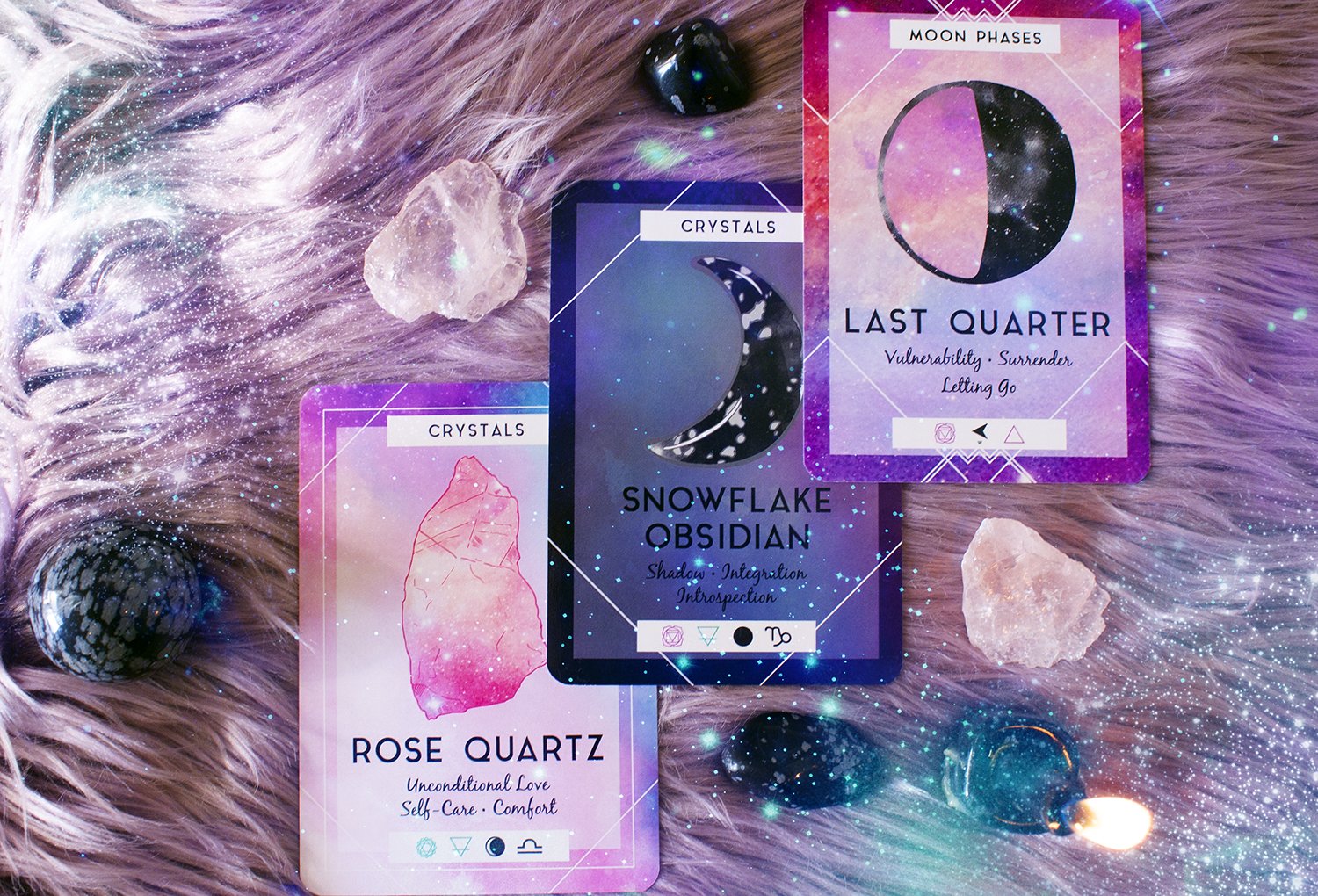
What is your relationship with letting go?
Ritual and magical practice can help us with more than manifesting, attracting, and calling in. It can also help us shed, let go, and transform ourselves and parts of our lives. The winter season invites us to incubate, release, and hibernate. It is an ideal time for release work (as well as the fall!). The phases of the moon that correspond to release are all the waning phases - the waning gibbous moon, the last quarter moon, the waning crescent moon, and the dark moon. Learn more about the phases of the moon with The Ritual Deck (pictured below.)
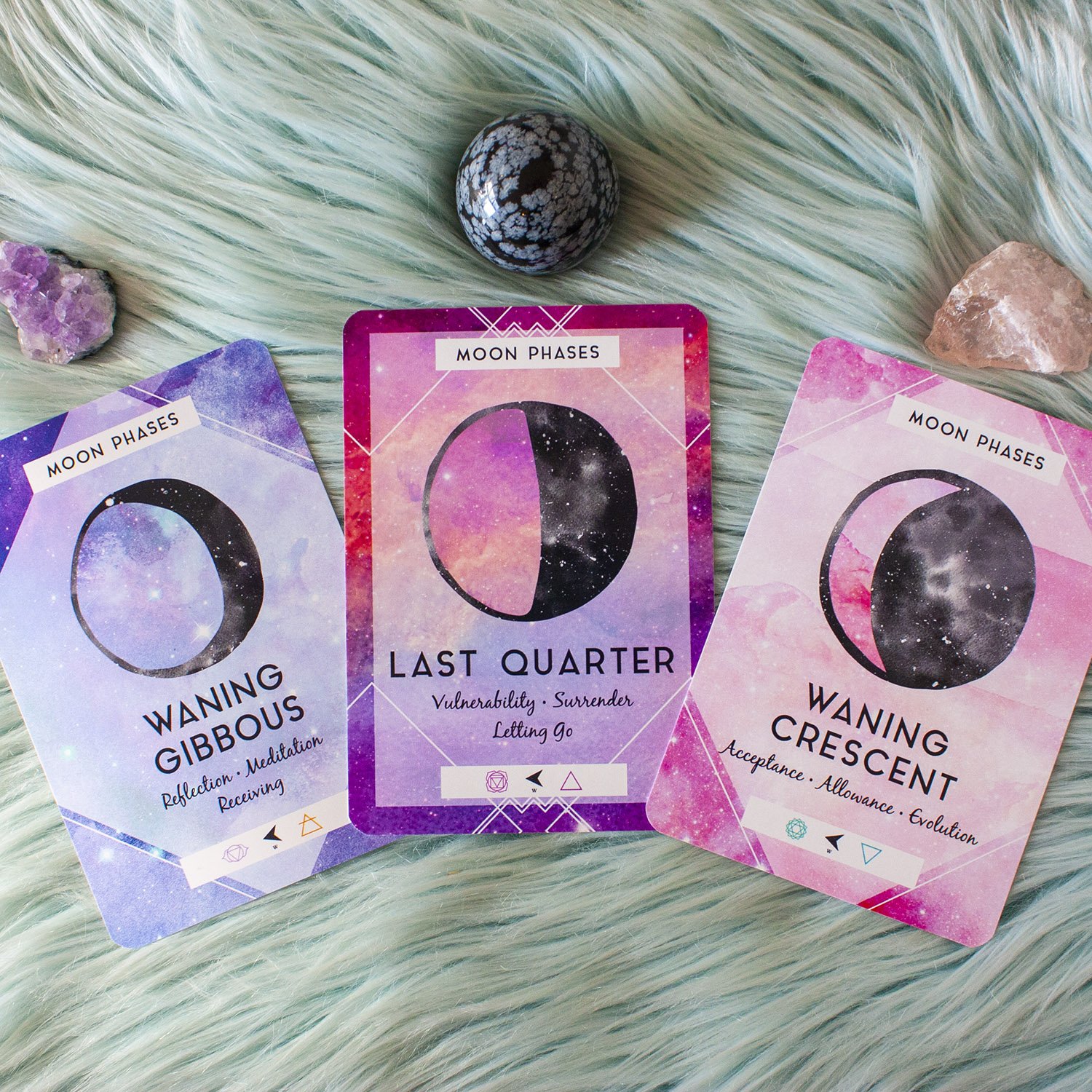
Before we get into the rituals, I also want to add that we can put a lot of pressure on ourselves to let go of things, and I want to honor that letting go can be really hard. Especially if what we’re letting go of has been something we have loved and cherished but is no longer a fit, feels comfortable, and/or feels safe.
So please, be gentle with yourself, be kind to yourself, and let release happen on your own timeline.
Keep scrolling to find a few rituals to support you in letting go.
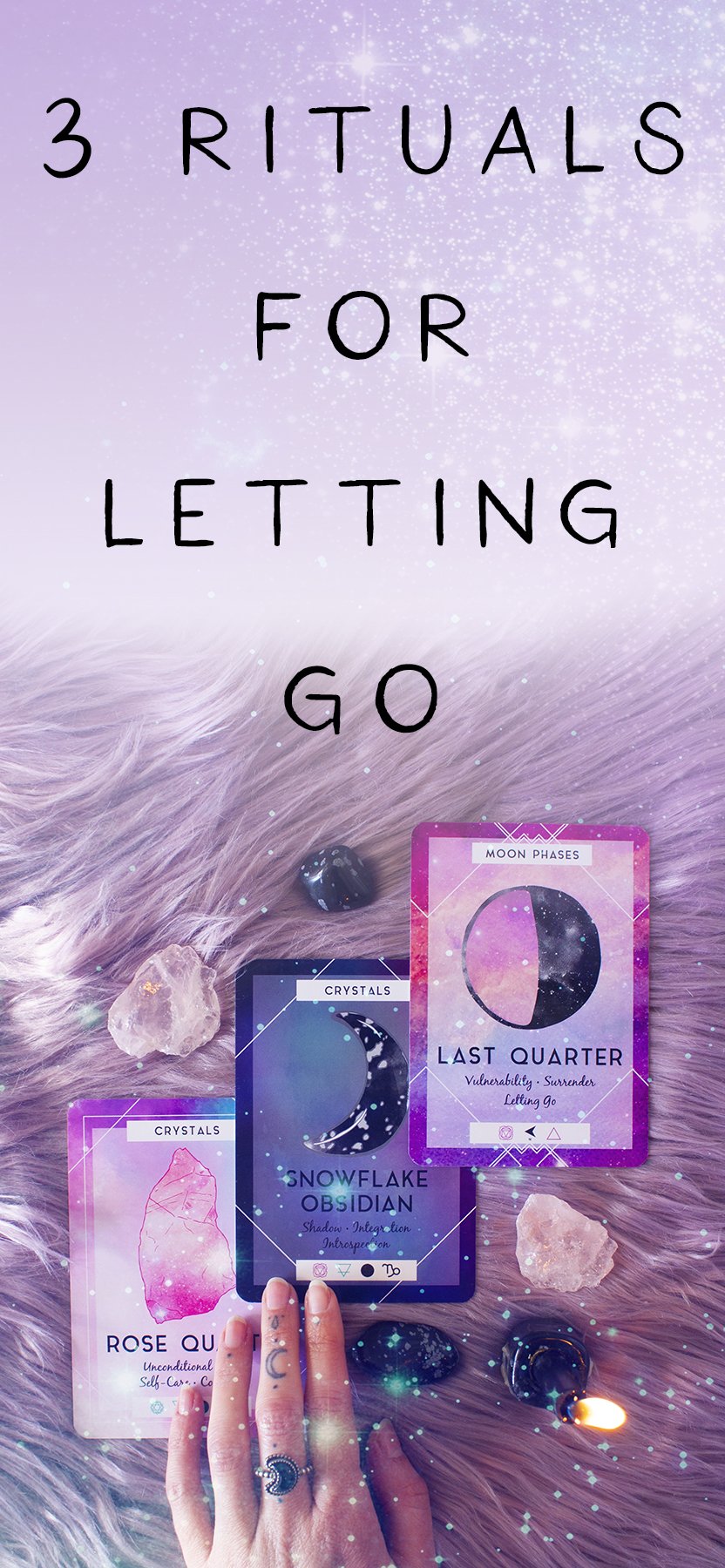
MOON RITUAL FOR LETTING GO
Our sweet, gorgeous moon is more than just an archetype, a deity, or energy. She is a real living body just like the Earth that we can go outside and look at, connect with, and talk to. I think sometimes we forget this but this is one of my favorite practices!
This is ideal to do when the moon is in its waning phases but still visible (so not the dark moon).
For this ritual, what you’ll need is yourself, an offering for the moon, and clarity on what you’re releasing. Your offering could be anything - a plate of your dinner, a glass of water, a branch, a flower, a drawing, a song - let your intuition guide you and go with what feels right.
When you have your offering, it’s ideal to go outside and sit or stand under the moon. If it’s really cold out or you don’t have space outdoors to do this, you can also sit by a window - that works just as well!
Take some time to center and ground yourself, entering a ritual space. Turn your gaze to the moon, ask to connect with her, and share your offering with her. Spend some time gazing at her and share your offering with her in whatever way feels good to you.
When you’re ready, tell her what you’re desiring to release. Ask for her help letting go. Sit in meditation, drawing down her energy and light through your crown and your whole body, letting this energy fill you up and either help you release whatever you’re desiring to release internally (blocks, fears, internal limits, ways of talking to self, etc), or charge you with the courage and power to release externally (a relationship, a job, a situation, project, etc.).
When you feel the energy shift, you know you’re finished! Thank the moon, ground yourself again, and spend some time journaling and processing afterward.
TAROT OR ORACLE SPREAD FOR LETTING GO
For this ritual, you’ll need your tarot or oracle deck and journal. Take some time to create a ritual space, whatever that means to you, and ground yourself before working with your cards. Set the intention to communicate with your highest self, spirit guides, ancestors, intuition, or any other deities or beings you had a relationship with.
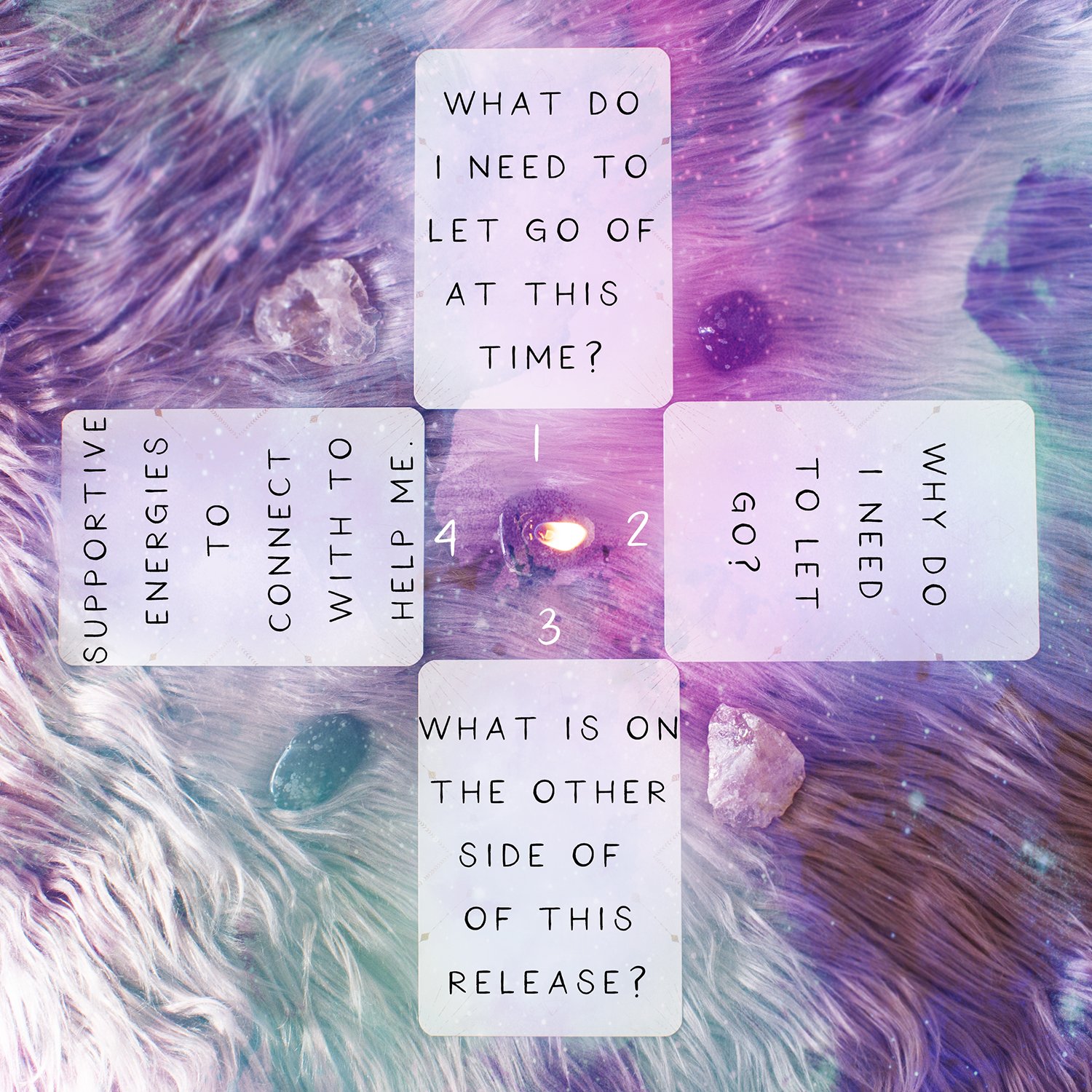
Once you’re fully present, shuffle your deck and pull cards for the following questions:
What do I need to let go of at this time?
Why do I need to let go?
What is on the other side of this release?
Supportive energies to connect with to help me let go.
Take your time with each card, really letting its messages move through you. I find it incredibly helpful to either meditate with my cards or journal about each card and what the spread means to me. I always get more information and a deeper understanding this way.
When you feel complete, it could be nice to add the cards to your altar - particularly the first and third cards - to support you throughout the release.
CANDLE MAGICK FOR LETTING GO
I love working with fire in spells and rituals, so naturally, I love candle magick! Fire is such a powerful element with its ability to transform and transmute - think of how fire turn logs into ash. It helps things change shape, die, and transform.
For this spell, you’ll need a black candle, a tarot card or oracle card representing what you’re releasing, and a safety pin to carve your candle.
Start by grounding yourself and casting your circle. Call in any supportive deities, guides, or other beings you have a connection with to join your circle and help you.
Next, you’ll want to intentionally choose the card from your deck that most represents what you’re releasing at this time. Take your time with this and really make sure you’re clear on what you’re desiring to release.
Once you have your card, it’s time to carve your candle. Carve into your candle any words and/or symbols that represent letting go to you. For example, I like to carve the glyph for Pluto into my candles when I work with releasing spells. Pluto represents change, rebirth, and transformation. Symbols and words work best when they’re personal to you, so don’t worry as much about the technical meaning and just intuitively choose what feels right to you!
Once your candle is ready, set it up with your card under it and take a few deep breaths. Speak your intention aloud as you light your candle, saying, “As I light this candle, I release X.” You might like to spend some time gazing into the candle flame as you focus on this intention.
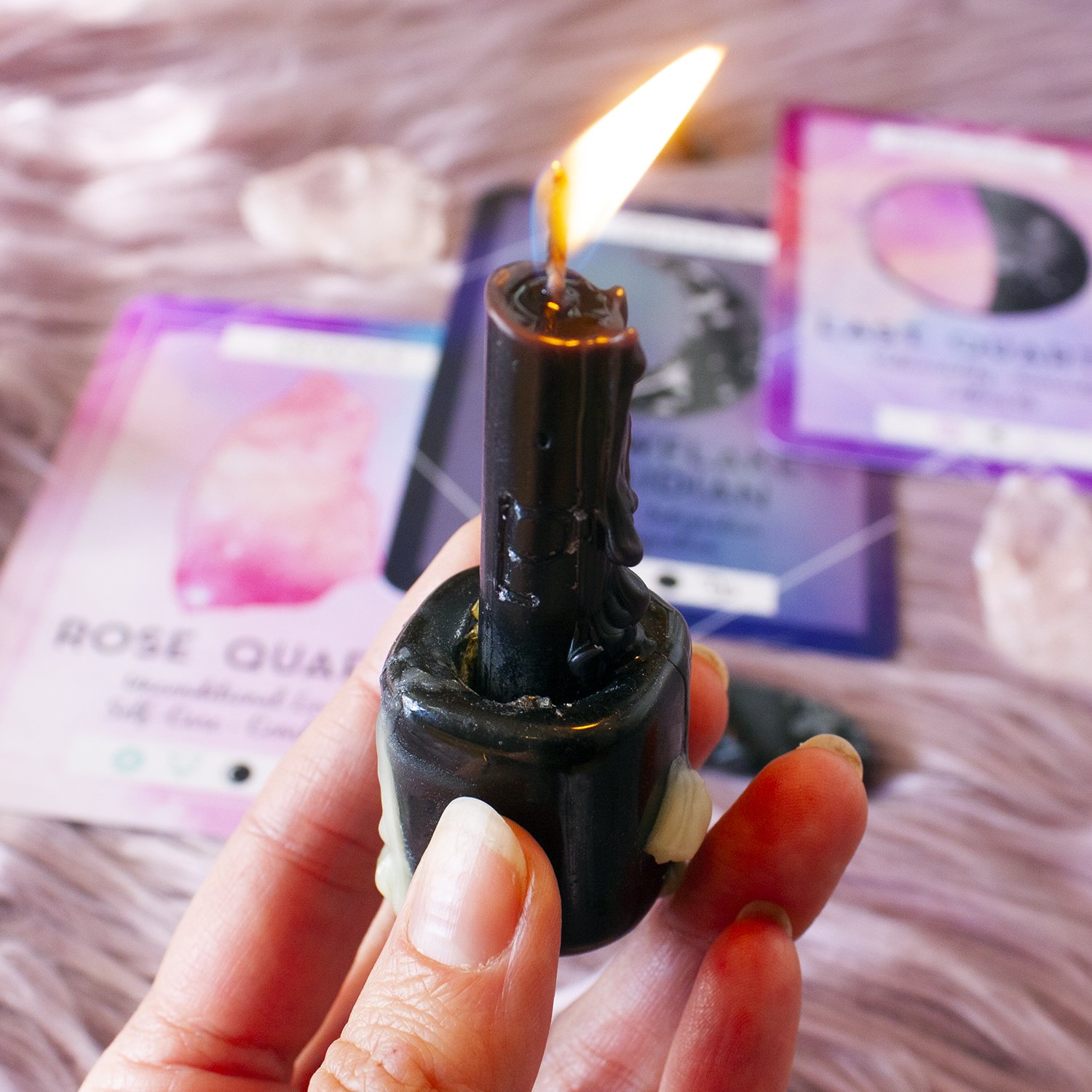
Then, it’s time to raise energy. You can raise energy however feels good to you - you might chant, sing, dance, do breathwork, or use any other tool that feels good to you. As your candle burns, you are raising energy in order to support this release.
When you feel the energy is at its peak, direct it with your intention towards releasing whatever it is you are releasing from your body, from your life.
When you feel complete, ground yourself again. Let the candle burn all the way down, thank any beings who joined you to help facilitate this release, and re-open your circle. Spend some time processing in your journal afterward, writing down what came up for you and what you felt.
